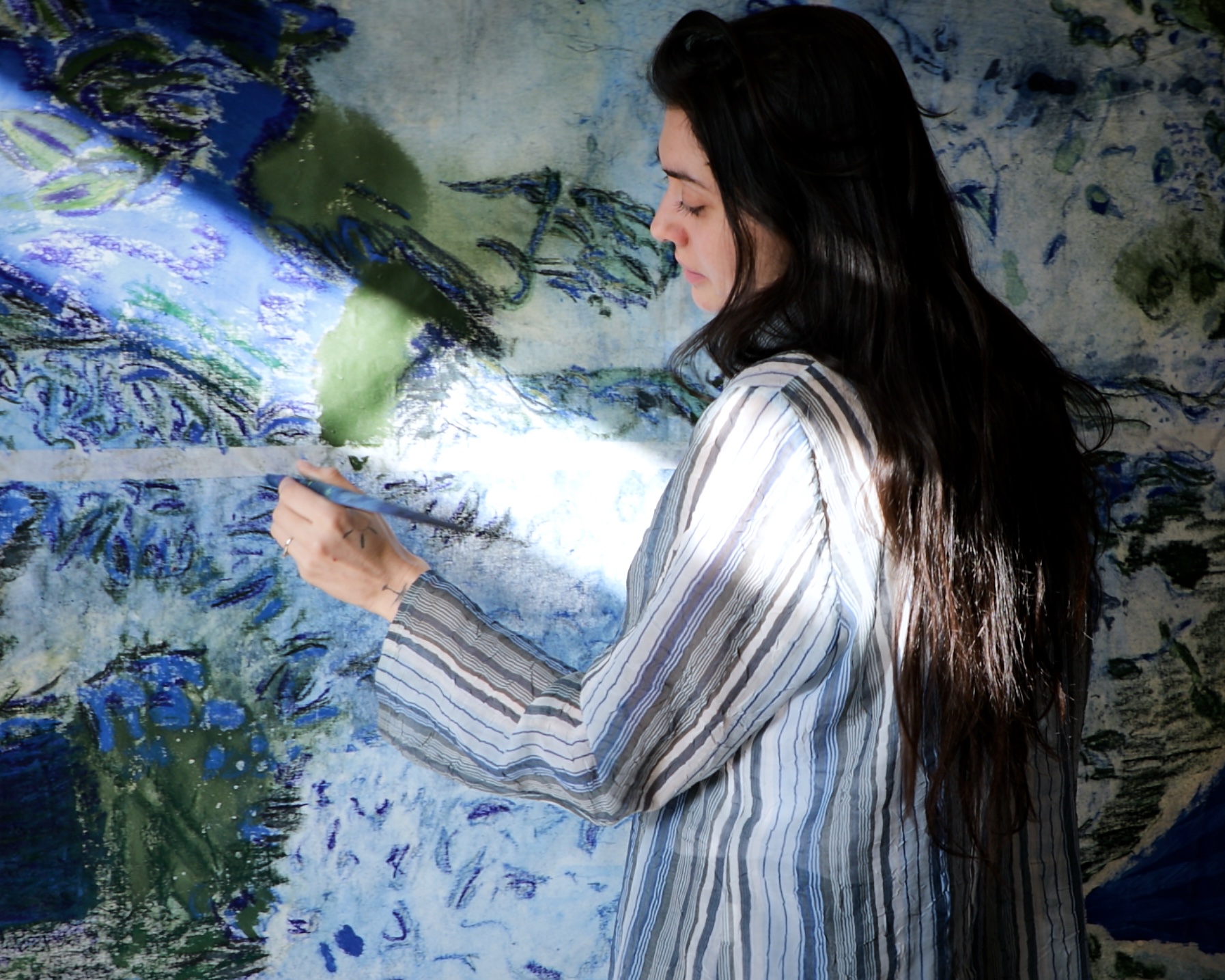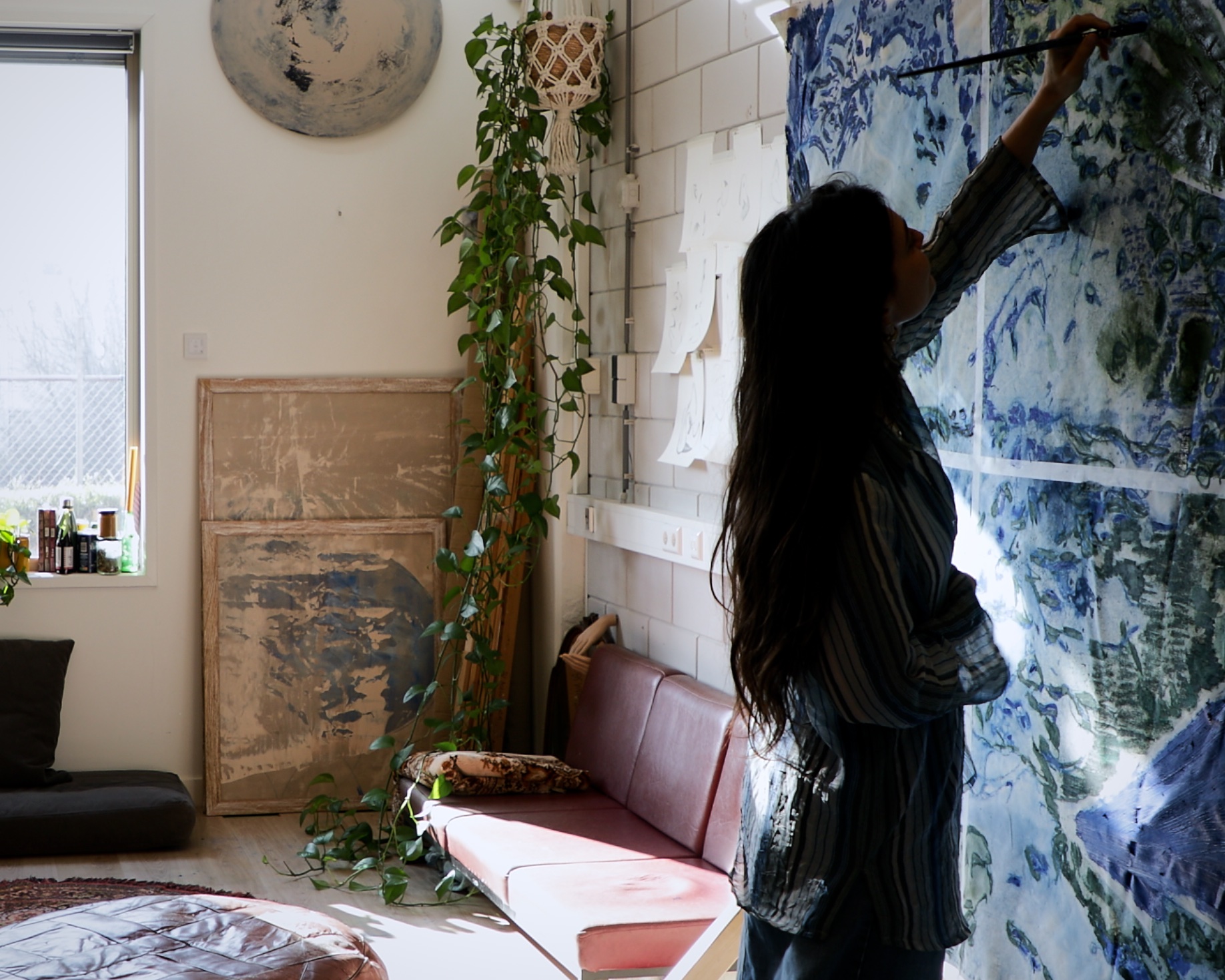- Where did you get your inspiration? Is there any particular meaning to using geometrics and patterns as the major elements in your work? Can you share the creative process with us?
I like to work large and with unconventional tools such as brooms and large wooden slats. For me, this works best for capturing large movements. My canvases usually start at about 6 meters and go up to 10 meters. I call this the mother cloth, and I cut this into a number of smaller works. This has always been my method. The mother cloth captures the energy and movement, which is what the action is based on, such as the attributes mentioned above. I continue experimenting with the interplay of nature and its elements, such as water and sun and develop a unique abstract style with psychological layers that are deeply personal and universal at the same time.
I take inspiration from people and their roles in society. The translation is quite abstract, and it is about the dynamics between light and dark. The appearance and disappearance of shapes and colors, just as people and situations. Without a preconceived plan, I tend to create canvases full of movement and feeling. Because of its fast-drying period, I mainly use acrylic, allowing me to paint in a preferred spontaneous manner. Through this intuitive process, I set out to create an intimate dialogue with my subjects.
Once the works have a base, I move on to the next layer, then I start using brushes, and lately, a lot of oil chalk has been used. This requires more planning and patience. There is less room for spontaneity, and geometric composition is involved, but at all times is abstract. Because my work arises from a mother cloth, there is no question of format or framing. How many works eventually come out of a mother cloth and whether this will be landscape or portrait always surprises me.
I have a natural curiosity about patterns and geometric rules. In my work, I explore the boundaries of intention and the opposing forces of logic and intuition by applying sacred geometry and an organic, instinctual-driven painting method—two contrary worlds.
It’s about the appearance and disappearance of these two matters and the playfulness between those two. It’s intuitive, abstract, and spontaneous, as if nature did its way. In every work, it is a disappearing and appearance of organic forms that together form themes. Social unrest on canvases where-countless energetic bursts of blue alternating in all sorts of hues. In contrast to the lightness, elusiveness, or tenderness of existence on canvases with light tones and paint that seems to be embedded in the canvas nest like a water stain. Next to a come-and-go from shape and color, you will also discover sacred geometric shapes in my work. Everything in nature leads back to these shapes. An important recurring aspect in my work is the blueprint of humankind, symbolized by the ‘Flower of Life’. By definition, the Flower of Life symbolizes creation and reminds us of the unity of everything: we are all built from the same blueprint. A visual connection expresses the life that runs through all living things is a token of spirituality. Some of my older work you refer to has been created with the same ideology, just a different painter’s hand at the time, and my work developed over the years.

- What other mediums or artistic styles are you looking forward to experimenting with in the future?
I included ceramics and glasswork in my solo show last September at Hama gallery. With these, I tried to adopt the same abstract quality as seen in my paintings.
As an artist, I like to evolve and work in different disciplines. I’m naturally driven and curious to see my own handwriting in new materials, 3d shapes etc, as I enjoy the interplay of water and sun, the translucent and movement in it. The Glass work was an obvious choice. It was important for me to have shape analysis as a starting point. Hand-blown glass is endless in its movement and shape degrees possibilities, and this really excites me. I titled the piece See the Rise, Feel the Sun, as a reference to the infinity of the cycle of the sun. An ode to nature, combined expertise and favorite material, hand-blown glass.
On the sculptural glass, echoing many of our circular landscapes, sit sheets of colored glass run through each other, through a subtle play of light and textures, magnifying the glass and the surrounding surfaces. Colorful transparencies and subtle overlays unfold before our eyes.
See the rise, feel the sun evoke a succession of waves, sunrises and sunsets, moon reflections on these abstract landscapes where the glass turns to glass. Eventually, glass binds to the landscapes.

